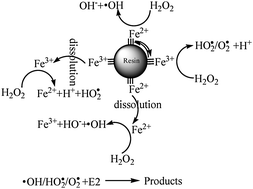When most people clean their hydroponic systems they use a hypochloride or hydrogen peroxide wash that they think kills all the bacteria and potentially hazardous substances within their setup. However few people realize that – although the system is indeed sterilized – the bast amount of harmful substances and chemicals (even those coming from the plastics themselves) remain intact after the attack of either hypochloride or peroxide. For example, many of the harmful plasticizers and complexes used for the making of PVC and other polymers remain intact after a rigorous wash with these two cleaning agents. So what can we do to truly clean our hydroponic systems and get rid of all the bad things that may be quietly waiting their turn to get into our plants ? The answer comes in the form of a very well known process used world-wide to clean water supplies from toxic chemicals : the Fenton process.
In the late 19th century, Henry John Horstman Fenton discovered a chemical process which was able to oxidize the most resilient organic molecules and turn them into harmless chemicals. As a matter of fact, Fenton’s process was so revolutionary that it sprouted a whole new area of research called Fenton chemistry in honor of its discoverer. What was this wonderful discovery ? Within the next few paragraphs you will learn what the Fenton reagent and process are all about and – most importantly – how this process can help you clean, I mean REALLY clean, your hydroponic system between growth cycles.
–
–
If you have been preparing your own hydroponic solutions and you have been using hydrogen peroxide then you already have most of the things you need to do some Fenton chemistry. The process basically works by adding a source of iron ions (they must NOT be chelated, like iron (II) sulfate) and hydrogen peroxide to a water solution. The iron ions then catalyze a series of reactions that generate powerful oxidizing radicals that destroy almost all harmful organic substances within your system. The iron ions are KEY to the Fenton process since they allow peroxide to generate this extremely reactive substances that are never present when peroxide exists on its own (reactions shown above). Research has found – for example – that phenol (a common chemical used as a model contaminant) remains unchanged in the presence of large concentrations of hydrogen peroxide while it is quickly destroyed in the presence of the Fenton reagent (Iron ions plus hydrogen peroxide). So what do you need to do ?
If you have been preparing your own hydroponic solutions and you have been using hydrogen peroxide then you already have most of the things you need to do some Fenton chemistry. The process basically works by adding a source of iron ions (they must NOT be chelated, like iron (II) sulfate) and hydrogen peroxide to a water solution. The iron ions then catalyze a series of reactions that generate powerful oxidizing radicals that destroy almost all harmful organic substances within your system. The iron ions are KEY to the Fenton process since they allow peroxide to generate this extremely reactive substances that are never present when peroxide exists on its own (reactions shown above). Research has found – for example – that phenol (a common chemical used as a model contaminant) remains unchanged in the presence of large concentrations of hydrogen peroxide while it is quickly destroyed in the presence of the Fenton reagent (Iron ions plus hydrogen peroxide). So what do you need to do ?
- First of all you should add about 0.2g of Iron (II) sulfate per liter of solution you will be using to clean your system.
- Then you should set your pH to a level between 3 and 3.5 using a STRONG non-organic acid such as nitric or sulfuric acid. You should NOT use citric, acetic or phosphoric acids since they lower the effectiveness of the Fenton reaction.
- Add as much peroxide as you would add to regularly clean your system. About 70mL of 50% hydrogen peroxide for each liter of solution works very well.
- Circulate the Fenton cleaning solution for at least 6 hours.
- Wash your system with water until no Fenton solution remains.
It is key for you to use a non-chelated iron source since chelated iron sources such as FeEDTA or FeEDDHA do NOT work well since the chelate does not allow the iron ions to properly react and participate in the Fenton chemistry that should be going on. The pH adjustment step is also vital since a pH above 5 would cause the formation of FeOH3 instantly upon the addition of H2O2 with the subsequent catalytic decomposition of all the H2O2 by the iron hydroxide (this is NOT something we want !). After you use the Fenton reagent to clean your system you will be certain that a lot of the harmful organic molecules that were present have been destroyed and your system will now be able to play as a sterile and harmless host to your new set of beautiful plants.





